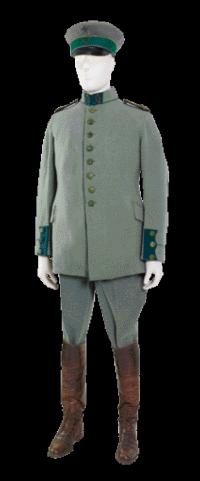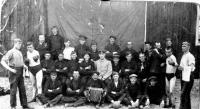Casement’s Irish Brigade uniform
Published in 20th-century / Contemporary History, Features, Issue 1(Jan/Feb 2012), Revolutionary Period 1912-23, Volume 20, World War I
Members of Casement’s Irish Brigade were issued a standard German army uniform, adapted to include Irish symbols such as the shamrock (cap) and the harp (cap and collar). (National Museum of Ireland)
During the First World War Germany attempted to use Irish resistance to British rule to open another front, both by recruiting captured Irishmen and by providing arms to the Irish Volunteers. In October 1914 Sir Roger Casement, a distinguished diplomat in the British service who had recently taken up the Irish cause, travelled to Berlin. He tried to persuade Germany to create a new ‘Irish Brigade’ from among Irish soldiers in the British Army captured by Germany. The Irish Brigade raised in eighteenth-century France had become famous in battles against the British, such as Fontenoy (1745), and Casement hoped to emulate this. In November 1914, 2,486 Irish soldiers were separated from British soldiers and transferred to Limburg.Irish Volunteer captain Robert Monteith attempted to recruit soldiers from among these prisoners of war, but Irish soldiers in Irish regiments of the British Army proved reluctant to join. A brigade in an army normally consists of c. 3,000 soldiers but Casement’s brigade never numbered more than 56 men. Those who did join were issued a standard German army uniform, adapted to include Irish symbols such as the shamrock and the harp. In the event, the unit never saw action against the British Army and neither did they receive pensions from the Irish government. Overall, German support for the planned rising in 1916 was lukewarm, but they did send a ship, the Aud, to bring 20,000 rifles (mostly captured Russian weapons) to the rebels. The Royal Navy, however, captured the ship at sea several days before the Rising; she was scuttled by her German crew while being escorted into Cork harbour. Most historians see Roger Casement’s time in Germany as a failure and, deeply disillusioned, he returned to Ireland in April 1916 by submarine in an attempt to prevent the rising. After eighteen months in Germany he felt that their support was inadequate for a successful rising. He was quickly arrested by the Royal Irish Constabulary on Banna Strand, Co. Kerry, and tried for treason. At the trial, some of his former Brigade comrades gave evidence for the prosecution and he was hanged in August 1916.

Recruits to the Brigade pictured in Germany—half of the total of 56 who joined up. (National Museum of Ireland)
HI Lar Joye is curator of military history at the National Museum of Ireland (Decorative Arts and History).
















